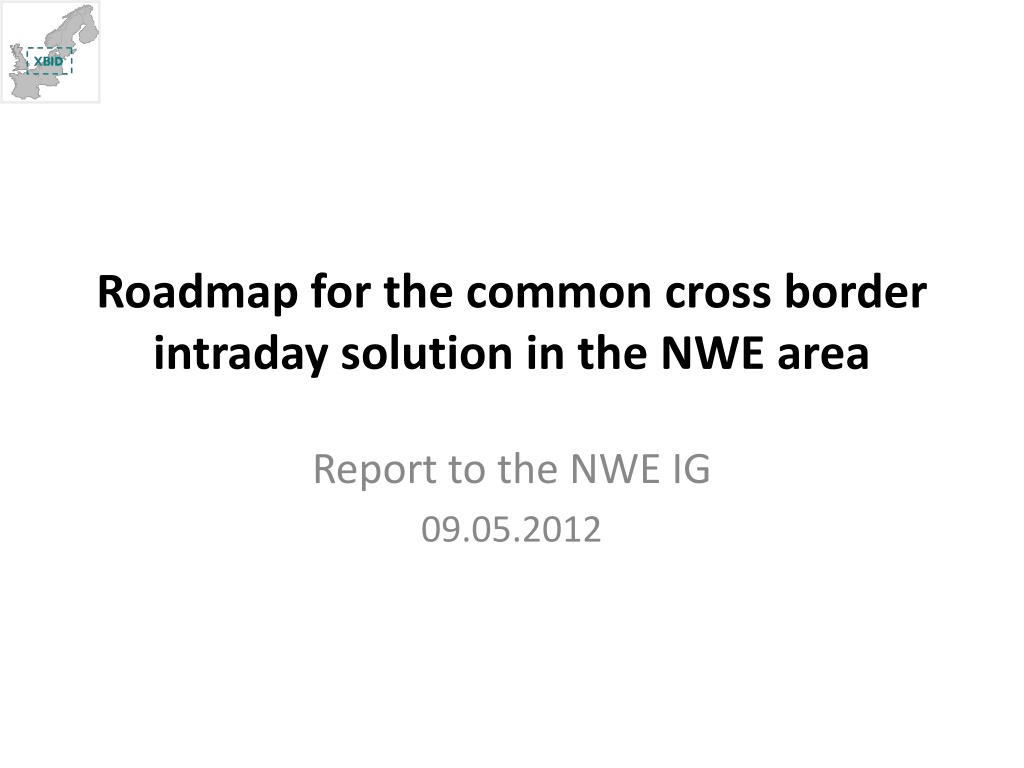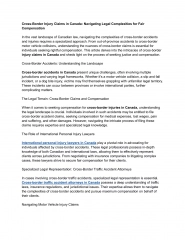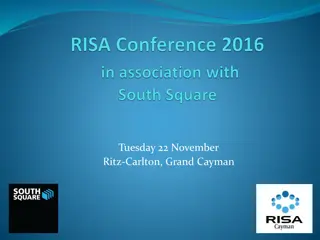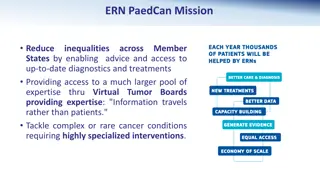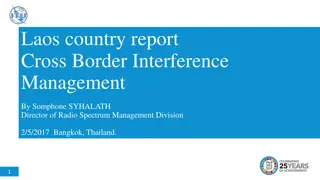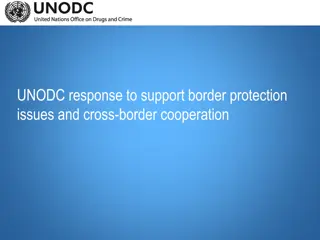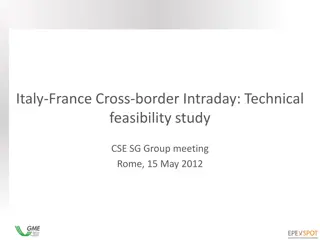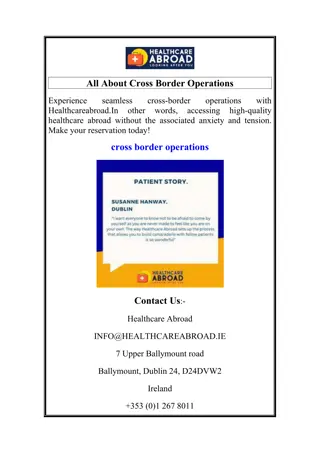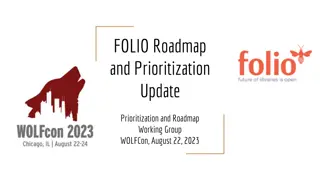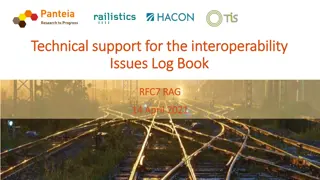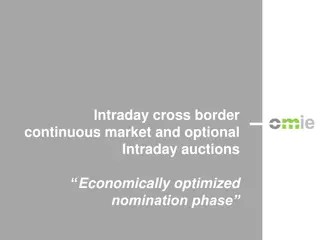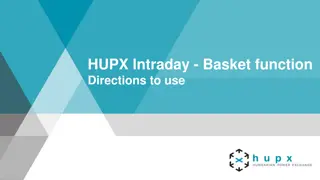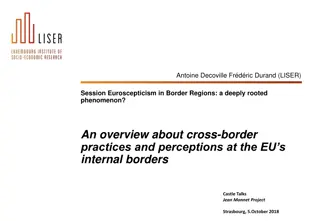Common Cross-Border Intraday Solution in NWE Area Roadmap
Conceptual representation of technical solutions, technical gap analysis with preliminary outcomes, phased implementation approach, and conclusions for the Common Cross-Border Intraday Solution in the NWE area are discussed. The presentation covers the Elbas structure, TSOs regions, PX interfaces, API implementation, and cost estimates for IT development. The PX-PX Cooperation Agreement, updated trading functionalities, TSO requirements, performance upgrades, and estimated implementation timelines are highlighted.
Download Presentation

Please find below an Image/Link to download the presentation.
The content on the website is provided AS IS for your information and personal use only. It may not be sold, licensed, or shared on other websites without obtaining consent from the author. Download presentation by click this link. If you encounter any issues during the download, it is possible that the publisher has removed the file from their server.
E N D
Presentation Transcript
Roadmap for the common cross border intraday solution in the NWE area Report to the NWE IG 09.05.2012
Content of the presentation 1. Conceptual representation of the technical solution 2. Technical gap analysis: Preliminary outcomes 3. Phased implementation approach: a possible way forward 4. Conclusions & Next steps
Content of the presentation 1. Conceptual representation of the technical solution 2. Technical gap analysis: Preliminary outcomes 3. Phased implementation approach: a possible way forward 4. Conclusions & Next steps
Conceptual representation of the Technical solution with a European scope Elbas structure TSOs Region 1 TSOs Region 2 Regional TSOs-PX interface for grid & net position data Regional TSOs-PX interface for grid & net position data Elbas core server Communication layer API (mainly) Joint Components * * means a common component that all PXs must all use when operating their cross border intraday market Elbas PX customer client Other applications (PX1, PX2 or customer systems) Elbas PX client Elbas admin client Elbas TSO client Elbas External capacity client Participating PXs Hub Hub Hub Hub
Content of the presentation 1. Conceptual representation of the technical solution 2. Technical gap analysis: Preliminary outcomes 3. Phased implementation approach: a possible way forward 4. Conclusions & Next steps
Technical Gap Analysis: Preliminary Outcomes Q2-2012: The PX-PX Cooperation Agreement sets the high-level requirements to be fulfilled by the Elbas starting point in order to finalize the selection process ( Technical Gap Analysis ) Based on: Updated trading functionalities (60%) PX operational needs such as clearing interface, Market Surveillance functionalities (10%) TSO high level requirements including explicit capacity reservation features (10%) Performance upgrade (20%) API implementation to offer interface for other PX s to connect the other markets (to be evaluated during May 2012) NPS and DIGIA system provider have provided the following estimations: Complete IT implementation time rough estimate is 18-21 months API development and implementation planning to be included during May 2012 Associated IT development cost rough estimate is 1.4 2 M (excluding implementation project PX+TSO expenses and API) Based on these new information, local implementation project still to be planned and budgeted with the concerned parties
Technical Gap Analysis: Main requirements Based on: Trading functionalities (60%) PX operational needs (10%) TSO high level requirements (10%) Performance upgrade (20%) API implementation (to be evaluated during May 2012) Mainly European developments: Joint Components requirements for the European IDCB Technical Solution
Technical Gap Analysis: Main requirements Based on: Trading functionalities (60%) All existing features in the German and French intraday markets; prioritization subject to Customer Group evaluation Trading tools & products: 15mn contracts; Iceberg orders, Fill-or-Kill, Fill-and-Kill order restrictions; Good-till-Date/Time; OTC-clearing Monitoring tools: Internal trade warning; Automatic orders deactivation in case of connection loss; Configurable order submission check for facilitated trading Trading interface: Design and screen display improvements to facilitate trading (e.g. blocks display ) PX operational needs (10%) TSO high level requirements (10%) Performance upgrade (20%) API implementation (to be evaluated during May 2012)
Technical Gap Analysis: Main requirements Based on: Trading functionalities (60%) PX operational needs (10%) Connection & access: Clearing interfaces; post-trading system interfaces Monitoring tools: Chinese wall between PXs Market Operation access; Sales & MO monitoring interface upgrades; use of certificates access instead of digipass; Trading limits based on collateral control... TSO high level requirements (10%) Performance upgrade (20%) API implementation (to be evaluated during May 2012)
Technical Gap Analysis: Main requirements Based on: Trading functionalities (60%) PX operational needs (10%) TSO high level requirements (10%) Explicit capacity access for OTC trading and XB balancing H2H Matrix display Market notification in case of capacity updates Halt/un-halt capacity allocation functionality per TSO/border Performance upgrade (20%) API implementation (to be evaluated during May 2012)
Technical Gap Analysis: Main requirements Based on: Trading functionalities (60%) PX operational needs (10%) TSO high level requirements (10%) Performance upgrade (20%) Improve real-time performances to increased number of orders, trades and concurrent logins Increase system availability rate and stability / modularity (implies renewal of the hardware architecture and further development of the system softwares) API implementation (to be evaluated during May 2012)
Technical Gap Analysis: Main requirements Based on: Trading functionalities (60%) PX operational needs (10%) TSO high level requirements (10%) Performance upgrade (20%) API implementation (to be evaluated during May 2012) Access for PX: to retrieve and submit trades, orders, flows, capacities Access for traders and other customers: to submit orders, retrieve market trades, data, messages
Technical Gap Analysis: Main requirements These preliminary outcomes of the technical gap analysis in terms of costs and implementation time appear more challenging than expected Possible approaches to be further investigated: The providers of ELBAS (NPS and DIGIA), with concerned PXs and TSOs, to review, finalize and possibly adjust the gap analysis estimations (costs and implementation time) Direct route towards the Enduring solution by 2014 could be considered in the light of these first and upcoming estimates on the Interim development Phase the development and local implementation approach, to ensure a timely and secured market integration
Content of the presentation 1. Conceptual representation of the technical solution 2. Technical gap analysis: Preliminary outcomes 3. Phased implementation approach: a possible way forward 4. Conclusions & Next steps
Phased implementation: a possible way forward SOB-CMM development roadmap Implementation phasing could secure an earlier readiness of the SOB/CMM system usable for NWE within 6 months - provided sufficient development resources are made available by the service provider (need to manage overlapping project phases) API development to be planned in parrallel if possible requirement to ensure NWE solution compatibility with the other regions
Phased implementation: a possible way forward Phased implementation approach with Elbas Efforts need to be maintained to carry-on the technical enhancements and ensure robustness of the solution Step-by-step system development enabling a timely implementation in NWE without delaying other regions With an adapted migration strategy, market integration can be done in a secured manner Prioritized (needed for go-live) Phased devt. (being detailed) Performance upgrades: Ensure high system usability TSO requirements: Explicit access functionality Performance upgrades: Higher performance and response time TSO requirements: Other functional requirements API implementation: Other customers access Common Joint Components requirements (necessary for all Europe) API implementation:* PX access PX operational needs: Chinese walls TSO requirements: Improved common and individual NWE TSOs requirements PX operational needs: Other specific system features Trading functionalities TSO requirements: Basic common NWE TSOs requirements PX operational needs: Essential compatibility features (clearing and post-trade access ) Specific NWE requirements *API development might not be necessary for NWE go-live, but is needed to enable pan- European compatibility of Elbas in a SOB-mode
Phased implementation: a possible way forward Phased implementation approach with Elbas Efforts need to be maintained to carry-on the technical enhancements and ensure robustness of the solution Step-by-step system development enabling a timely implementation in NWE without delaying other regions With an adapted migration strategy, market integration can be done in a secured manner Prioritized (needed for go-live) Phased devt. (being detailed) Performance upgrades: Ensure high system usability TSO requirements: Explicit access functionality Performance upgrades: Higher performance and response time TSO requirements: Other functional requirements API implementation: Other customers access Need to be ready by end 2012 in order to allow for NWE implementation process compatible with other regions Common Joint Components requirements (necessary for all Europe) API implementation:* PX access PX operational needs: Chinese walls TSO requirements: Basic common NWE TSOs requirements PX operational needs: Essential compatibility features (clearing and post-trade access ) TSO requirements: Improved common and individual NWE TSOs requirements PX operational needs: Other specific system features Trading functionalities Specific NWE requirements *API development might not be necessary for NWE go-live, but is needed to enable pan- European compatibility of Elbas in a SOB-mode
Phased implementation: a possible way forward SOB-CMM development roadmap Finalization of Phase 1 is a prerequisite for the go-live of local projects Elbas technical implementation Phase 2 Implementation (Interim) Phase 3 Implementation (Interim) Content of the Implementation to be further defined Gap analysis finalization & selection of Phase 1 delivery items (Ready by 31.5.2012) Technical improvements and adaptations of ELBAS Initial SOB / CMM system release ready for full implementation in NWE: Go live 31.12.2012* Development & test of phase 1 delivery items + go-live preparation Content of the Implementation to be further defined Local project 1** Technical implementation of Elbas on NWE local hubs and borders Local project 2** Local project ** Enduring solution technical preparations * Subject to succesfull testing w/o contingencies 18 ** Cross-border implementation plannings to be established with TSOs
Phased implementation: a possible way forward System migration strategy / EPEX proposal While phasing approach will ensure a timely implementation of the IDCB solution in NWE, many requirements to ensure full compliance with market needs will need to be developed stepwise An adapted migration strategy is necessary in order to migrate the liquidity in the Elbas solution for Germany, avoiding fly of liquidity to the OTC market - which will provoke inefficiencies on capacity allocation as a side effect This is why EPEX proposes a parrallel-run migration strategy
Phased implementation: a possible way forward System migration strategy / EPEX proposal DE-DK DE-DK DE DE Elbas (NPS) DE DE-NL Elbas SOB (NPS+EPEX) Elbas SOB (NPS+EPEX) DE-NL ComXerv (EPEX) OTC DE-FR OTC ComXerv (EPEX) ComXerv (for 15mn products) DE-FR OTC Step 1: (for any of the 3 scenarios explained Elbas is deployed in a SOB mode in Germany; liquidity starts to be transferred, and ComXerv is maintained in a short transitory period as a safety net, until SOB robustness is ensured Today: 3 pools of liquidity in the German intraday market Successful migration: SOB becomes the main pool of liquidity above) DE-DK DE DE-NL Elbas SOB (NPS+EPEX) DE-FR OTC ComXerv (for 15mn products) Unsuccessful migration: liquidity vanished from Exchange trading
Some observations Once the ELBAS SOB is in place, the sequencing of the XB local projects is not dependant of any technical considerations On the critical path, there are the technical readiness of the ELBAS SOB and implementation of the ELBAS SOB in France and Germany ComXerv used by EPEX in Germany is the main liquidity pool in NWE. French liquidity is dependant of its connection with the German pool of liquidity, not the contrary Post coupling activities have to be considered in the planning UK will have to be considered in a further step
Content of the presentation 1. Conceptual representation of the technical solution 2. Technical gap analysis: Preliminary outcomes 3. Phased implementation approach: a possible way forward 4. Conclusions & Next steps
Implementation scenarios Assumption for first 3 scenarios: To have ELBAS SOB-CMM technically ready with version 1 (which is the must-have of the requirements) delivered by end of 2012 (tbc) Scenario 1 first pooling of liquidity in DE ; DE-NL /DE-DK projects in the meantime; and finally DE-FR/BE-FR projects Step 1: Implement ELBAS SOB in Germany and start to pool the liquidity in it while using ComXerv in parallel (for a limited transition migration period and for 15 product) Step 2: TSOs and PXs to implement GE-DK and GE-NL local projects by meaning no longer DBS at these borders but still ComXerv / DBS for DE-FR Step 3: Once liquidity is pooled in Germany then implement ELBAS SOB in France / TSOs and PXs to implement GE-FR and FR-BE local projects / ComXerv remains in Germany only to deal with 15 products. All hourly products will be traded over ELBAS Scenario 2 first DE-FR XB (based on new DE and FR Elbas ID markets), followed by other XB projects Step 1: Implement ELBAS SOB in Germany and France (while using locally only ComXerv in parallel in Germany - not connected to France (for a limited transition migration period and for 15 product) Step 2: TSOs and PXs to implement XB local projects without waiting for a full liquidity pooling in Germany: FR-BE, GE-FR,GE-DK and GE-NL by meaning no longer DBS at these borders / All capacities will be given towards ELBAS / ComXerv remains in Germany only to deal with 15 products Scenario 3 (for exhaustiveness purposes only) first implement Elbas in FR, then XB project FR-BE, then pooling liquidity in DE and finally other XB projects DE-FR, DE-DK and DE-NL Step 1: Implement ELBAS SOB in France / TSOs and PXs to implement FR-BE local project (MP in FR will have -during a limited timeframe - to enter XB bids towards DE in ComXerv platform, as all other deals will be submitted in ELBAS to have a XB link towards BE; French liquidity will be splitted) Step 2: Implement ELBAS SOB in Germany and start to pool the liquidity in it while using ComXerv in parallel (for a limited transition migration period and for 15 product) Step 3: TSOs and PXs to implement GE-DK, GE-NL and GE-FR (all the French liquidity being in the meantime pooled into ELBAS) local projects Scenario 4 Direct route towards the Enduring solution by 2014 could be considered in the light of these first and upcoming estimates on the Interim development These possible scenarios are built on high level information (refined costs, planning and feasibility information to be provided shortly by PXs)
Conclusions & Next Steps 1. Work on PX-PX Cooperation Agreement to be finalized during Spring, in order to set-up the PXs common project governance and technical requirements Need to be completed concurrently with the ENTSOE-Europex MoU on IDCB cooperation 2. ELBAS developments to meet the full set of SOB-CMM requirements appear to be more challenging than expected. Consequently a phased approach (with only must-have requirements in the first phase) has been suggested. Subject to confirmation by the Elbas service provider, phase 1 can be completed by end of 2012 so that the SOB-CMM for NWE is technically ready by this year API implementation to ensure NWE compatibility with Europe still to be assessed and prioritized Local projects to be scheduled as soon as possible (Finalization of Elbas development Phase 1 is a prerequisite for the go-live of local projects) 3. Several sequencing scenarios are currently being contemplated, with the objectives to 1. Implement Elbas SOB-CMM on all NWE hubs and borders rapidly 2. Secure successful liquidity transfer to the SOB in Germany
